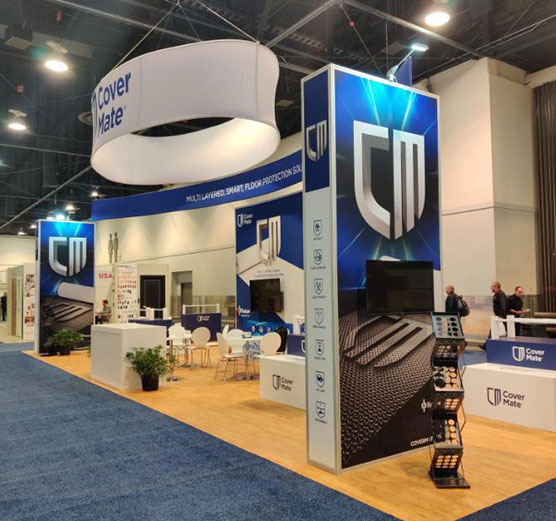Modular versus Custom Exhibition Stands? Choosing your perfect stand

Choosing an exhibition stand for your next exhibit is not an easy task as there are several options available. In the industry, there are several stands available but two of them are the most commonly used. One is Modular and another is a custom exhibition stand and each of them comes with some pros and cons. Between both of these stand types let us discuss the key differences between Modular versus Custom Exhibition Stands. To decide which type of stand is the most suitable for you this article will help you.
What are Modular Stands?
Modular stands also referred to as system or shell scheme stands, are pre-fabricated structures comprised of interlocking pieces or modules. The modules allow the stands to be assembled on-site as they come in pre-set sizes and configurations. Modular stands provide basic shell space that exhibitors can outfit themselves with lighting, graphics, and furnishings.
Major advantages of modular stands include:
Budget Friendly –
Modular stands tend to be significantly less expensive than custom stands. Prices start at a few hundred dollars and scale up depending on the size and add-ons selected. Especially for startups and small businesses with limited exhibition budgets, this makes them an affordable option.
Speed and Ease of Setup –
Since modular exhibition stands arrive as pre-assembled modules or panels, setup and dismantling are a breeze. Exhibitors simply slot the pieces together on site as per the floor plan. By minimizing labor costs Modular stands help achieve a quick turnaround.
Standard Sizes –
Modules are available in fixed widths, depths, and heights to conform to standard booth dimensions. This allows for uniform, symmetrical aisleways without custom infrastructure.
Consistent Look –
Using the same standardized modular pieces gives all booths in a trade show a uniform, coordinated appearance following event branding guidelines.
Inventory Management –
Show organizers need to stock a limited set of modular components in their inventory that can be reused for multiple events. However, modular exhibition stands also have some significant limitations:
Lack of Customization –
Exhibitors have very little flexibility to modify or customize designs as per their specific requirements. They need to work within the confines of pre-set modules, sizes, and configurations.
Basic Aesthetics –
By design, modular stands have a plain, boxy appearance that cannot match the style and finish of bespoke custom constructions. For branding impact graphics and decor become important.
Shared Partitions –
Adjacent booths share common walls/partitions which limits individual space-defining opportunities and visibility into neighboring aisles.
Height Restrictions –
Modular stands conform to standard height limits set by organizers which may not sufficiently showcase large or unusually shaped products.
For businesses that require highly customized solutions or those looking to create a real ‘wow factor’, a modular stand may not adequately meet exhibition objectives on its own. This is where custom-designed stands can come in very handy.
What are Custom Stands?
Custom stands are fully bespoke exhibition structures tailored to fit a client’s exact specifications, budget, and space requirements. Unlike modular stands which use fixed components, custom stands can be completely unique designs conceived from the ground up.
Some major advantages of custom-designed stands include:
Unlimited Customization –
Virtually any design, shape, size, color, or material can be incorporated. Stands can highlight brand identity, products, services, or events in a customized manner.
Distinctive Appearance –
Well-designed custom stands immediately capture attention through unique architectural elements, theming, and finishes that set them apart from standardized modular booths.
Flexible Layouts –
Layouts are not restricted to standard dimensions or configurations, allowing focused space allocation and maximum visibility from all angles.
Accentuate Products –
Enormous and specialized exhibits featuring unusual shapes, sizes, or weights of products can be seamlessly incorporated into custom stand designs.
Create Impact –
Bespoke elements like LED walls, multimedia features, props, or interactive elements allow custom stands to truly ‘wow’ audiences and uplift brand experience.
Personalized Service –
Highly customized solutions are developed through a collaborative process, addressing client goals, venue needs, and audience personas more holistically.
Of course, custom exhibition stands also have their limitations:
Increased Costs –
Expect custom stand fabrication costs to be significantly higher than modular options, often running into tens of thousands based on size, complexity, materials, and finish quality.
Lengthier Approvals –
Design iterations and structure approvals may take longer due to the bespoke nature versus standardized modular items.
Scheduling Challenges –
Tight build timelines pose difficulty for complex assemblies that aren’t pre-fabricated off-site. Last-minute design changes become problematic.
Transport Logistics –
Transporting, assembling, and dismantling unique custom structures on location also requires careful planning and logistical support.
So in summary, modular stands offer affordable standardized solutions while custom designs enable the highest differentiation – but at a premium. For most clients, a hybrid approach combining the strengths of both may work best.
Hybrid Stands – The Best of Both Worlds
An increasing number of clients are asking exhibition stand builders for exhibition stands that provide elements of both modular and custom structures. Referred to as hybrid stands, these solutions carefully blend pre-fabrication efficiencies with targeted customizations.
Some ways hybrid stands achieve this balance include:
Modular Shell and Custom Infill – Standard booth frames, walls, or structures form the basic shell or ‘skeleton’ within which unique shapes, graphics, or interior modules can be incorporated.
Accents with Custom Walls/Facade – Key structural aspects like walls, and roofs use custom panels but interiors feature modular furniture, and lighting accents.
Modular Floorplan with Custom Alcoves – The core booth footprint uses fixed modules; however, in certain circulation zones, product displays use customized construction.
Framework plus Specialized Configuration – Modular truss or panel kits assemble into an unconventional layout with angled walls or unorthodox multi-level formats.
Modular Counters/Seating plus Custom Focal Point – Standard seating/meeting areas surround highly customized, dimensional centerpiece-like interactive displays.
The selective incorporation of bespoke elements within an overall modular framework helps achieve several desirable qualities:
Lower Costs – Significant modular component reuse maintains affordable pricing while adding flair.
Faster Construction – Pre-fabricated modules assemble rapidly on-site with limited custom building.
Flexible Designs – Targeted bespoke zones facilitate creative solutions within standardized perimeters.
Coordinated Appearance – Hybrid stands fit within branding schemes set by organizers.
Simplified Logistics – Moderately complex hybrids pose fewer transport challenges than fully customized exhibits.
Iterative Process – Modular elements serve as a foundation to build out high-impact bespoke features collaboratively.
So in many cases, hybrid exhibition stands represent the ideal middle path marrying the benefits of both modular and custom options. For businesses looking to right-size their investment, these stands provide an excellent solution.
Factors to Consider When Choosing
With an understanding of modular, custom, and hybrid stand options, it’s time to weigh key criteria for selecting the right solution:
Budget –
Available funds will either expand or constrain design possibilities. Custom builds become prohibitive above a threshold.
Schedule –
Timelines influence the feasibility of iterative custom design processes versus plug-and-play modular configurations.
Space Requirements –
Standard sizes may suffice or unusual dimensions necessitate tailor-made constructions.
Branding Goals –
Distinctive identities require maximum personalization while standardized booths fit coordinated events.
Product Showcase –
Complex/oversized goods demand fully customized installations while simple demos utilize modular fixtures.
Interactivity Level –
Robust multimedia, motion graphics, or hands-on interactivity warrant specialized personalization.
Staffing –
Employee-heavy stands may rely more on pre-built efficiencies versus fully customized solutions that require on-site assembly assistance.
Regulatory Compliance –
Venue/safety regulations may constrain design flexibility necessitating modular conformity.
Transport Method –
Off-site fabrication helps avoid onerous transport/assembly of monumental custom structures.
Reusability –
Intent to reuse assets across multiple events favors temporary modular structures over single-use custom builds.
Every business must weigh these criteria based on their unique goals, budgets, products, and event constraints. To shortlist the right solution valuable input can be provided by consultation with experienced exhibit professionals.
Best Practices for Customization
If opting for a modular exhibition stand or hybrid stand, it’s important to maximize the impact of any custom elements through strategic best practices:
Develop Theme/Identity –
Anchor the design conceptually before layering in custom visuals/features. Through graphics, materials, and color palettes create continuity.
Accentuate Focal Points –
Ensure dominant attention-grabbers like dimensional signage, media walls or product enclosures steer traffic effectively.
Sculpt Space –
Exploit three-dimensional design opportunities through forms, and shapes that break the rigid geometry of modular booth shells.
Curate Interactivity –
Custom demos, touchscreens, and scannable/responsive elements nurture engagement far beyond passive branding.
Stage Lighting Professionally –
Uplighting, accent fixtures, and motion/color-changing theatricals imbue mood and polish overall presentation.
Source Quality Finishing –
Realistic props, textures, and material choices elevate the tactile experience over low-grade compositions.



